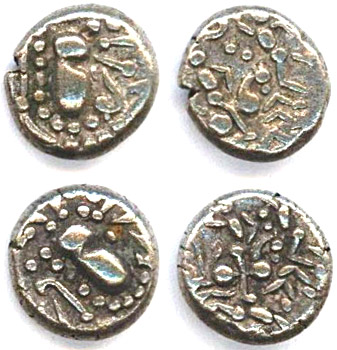 Silver coins of Western India were not merely bullion and this statement is apparent from the archaeological evidences. The silver coins were issued by the Silahara ruler Chhittaraja, king of the- North Konkan, the narrow coastal plain of West India stretching from Thane in the north to Ratnagiri in the south. The reverse of the silver coins bears a Devanagari legend, in the exact style of the epigraphs of Chhittaraja. The mean weight of 15 of these coins is around 3.48 g, with a coefficient of variation of 6.9 per cent. The Chhittaraja Gadhaiya is reported to have been found in Ratnagiri District. Drammas are specifically mentioned in an inscription of Chhittaraja. Those appear to be a local issue mimicking the Gujarat coins which passed down the Konkan coast in trade.
Silver coins of Western India were not merely bullion and this statement is apparent from the archaeological evidences. The silver coins were issued by the Silahara ruler Chhittaraja, king of the- North Konkan, the narrow coastal plain of West India stretching from Thane in the north to Ratnagiri in the south. The reverse of the silver coins bears a Devanagari legend, in the exact style of the epigraphs of Chhittaraja. The mean weight of 15 of these coins is around 3.48 g, with a coefficient of variation of 6.9 per cent. The Chhittaraja Gadhaiya is reported to have been found in Ratnagiri District. Drammas are specifically mentioned in an inscription of Chhittaraja. Those appear to be a local issue mimicking the Gujarat coins which passed down the Konkan coast in trade.
Other coins are some peculiar types of Chalukya silver gadhaiya issued in the name of in Somala Devi. Gold coins attributable to Gujarat kings in this period were extremely rare or even non-existent. The Gadhaiya billon coins, in contrast, were plentiful. For instance, one hoard alone from the Bhinmal region has yielded close to one hundred thousand specimens. The acceptability of the Gadhaiya Drammas in trade is matched by major circulation areas in Sind, central Rajasthan, the Konkan, and Maharashtra.
The pattern of coastal trade by which goods from the Konkan were brought to Gujarat ports for transhipment to West Asia or Southeast Asia is suggested by the Gadhaiya coinage finds along the coast. Rather, there was a slow evolution with design elements undergoing a gentle metamorphosis. Distinctive stages of this evolution have been selected which are immediately differentiable from earlier and later stages, and been given arbitrary status as separate coin types, for the sake of convenience. The single most important fact deduced from exposition of the silver coins of Western India is the progressive debasement of the coins with time. The earliest, called `Gojigga`, had a net silver content of 3.27 g; the `Dauraha` through `Chorimori` were a quantum 14 per cent less, at a mean of 2.80 g; the `Karada` through `Bhimapuri` were another quantum of 28.8 per cent less, at a mean of 1.99 g. Thereafter there was a continuous trend of debasement until the end of the series, the minimum quoted here being 0.73 g.
Further, the silver coins of Western India had stable precious metal content. Only in the thirteenth century, with the passing of portions of Gujarat`s commercial hinterland (Sind and northern Rajasthan) into the Turkish sphere of influence, is there evidence of chronic debasement. This can also be associated to silver shortages, inflation or loss of trade revenues in Gujarat associated with the establishment and expansion of the Delhi Sultanate.






